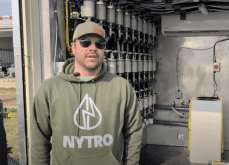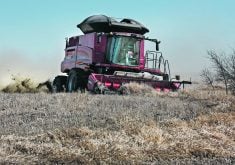PICTURE BUTTE, Alta. Ñ To simplify the spring seed treatment process, Haney Farms near Picture Butte, Alta., uses a farm-built mobile seed treating system.
“With this unit, the basis was a Versatile 400 swather. It’s a totally self-contained unit. Rather than push, pull or drag (equipment around), the machine drives itself from bin to bin as required. With a twist of a directional lever, you’re treating with Dividend or Dividend Supreme Pak,” said Don McDowell, seed business manager with Haney Farms.
Power for the electric auger on the seed treater comes from an 8 kW generator, driven off a pulley between the swather’s engine and hydraulic pump.
Read Also

VIDEO: Ag in Motion documentary launches second season
The second season of the the Western Producer’s documentary series about Ag in Motion launched Oct. 8.
“It will give you 110 single phase, 220 single phase and 220 three phase,” said Brad Elford, who operates the seed plant.
“The motor on the top that loads your truck is a three-phase three horsepower motor. You can run it backwards to clean it out. There’s a flip switch on the side panel, with forward, reverse and neutral.”
When not in use treating seed, the unit can also be used as a mobile generator.
“Right now it’s at a gravel pit running a gravel screener,” said Elford. “If you need an air compressor, you can run it out and do things like blow a bin out or blow a tire up. If you need to grind something or use a drill in the feedlot, you could use it there.”
In place of the swather table, a platform on the front carries the chemical kegs.
A hopper on the right side feeds seed from granaries into a Graham G3 seed treater, where the seed treatment is applied. Seed then drops into a second hopper and is augered into the customer’s truck.
“It’s an eight-inch diameter, 22 foot auger. We can fill seed tanks that come in on the backs of tandems. That’s about the stretch for this,” said McDowell.
“The chemical comes in totally sealed totes. We do the precalibration at the start of the year. Then it’s a matter of knowing your grain flow.”
When treating seed, the engine for the Versatile swather has to be running, to generate power for the treater.
“The auger on the treater is electric. We do have transfer augers that are electric, as well. Rather than worry about running extension cords down a row of bins, they can be plugged into the generator on the treater. And you can hook up lights at night, to make it safer,” said McDowell.
To move grain from the bins to the treater, they use 36 foot long, eight-inch diameter augers with 20 horsepower Honda motors, or short transfer augers.
“The treater pulls up to those augers and it’s just a matter of opening the bin to a preset mark, turning the valve and away you go. Last year, when everything was said and done, the number of bushels that went through the treater, versus the litres of seed treatment we used, we were within less than one percent. The accuracy is phenomenal, which is a credit to the machine and also the operator,” he said.
“Chemical treatment is so expensive now. The days when we used to slop Vitavax around are long gone. The new wireworm treatments are in the four to five dollar a bushel range, so accuracy is of the utmost importance.”
Elford said when treating with Dividend or any water-based treatment, the treater won’t do much more than 22 bushels a minute. He typically treats about 20, which works out to around 1,200 bu. an hour.
“The bottleneck in the system is the Graham seed treater. The seed treater has the ability to auger more grain than that, but in order to get proper coverage, the recommended rate on wheat is 1,200 bu. an hour.”
On the right side of the swather frame, a chemical handler is mounted at the front, and an air compressor at the back. The air compressor provides pressurized air for the chemical applicator and can be used for cleanups.
“The kegs run on 30 pounds of air. With a compressor on board, as long as you’ve got chemical, you can continue to run with accuracy. One charge of the air tank is good for two 55-litre kegs of Dividend,” said McDowell.
Most farmers have already cleaned their trucks when they come in to pick up seed, but the odd bit shakes down out of the rails and tarp. Sweeping some of the older trucks can be difficult. McDowell said it’s easier to use the air compressor to blow out the truck and clean it down before receiving the seed.
The air compressor is also used for cleaning the treater.
“When we run (the treatment auger) backwards to clean it out, there’s a hatch on the bottom of the auger. I stick a bucket under there, run it backwards and blow it out,” said Elford.
McDowell said work on a seed farm is demanding, especially in spring when farmers are anxious to get preparations done for seeding.
“They expect to come in here, get their seed and be gone. Having everything on the mobile treater makes it so much easier to get the farmers what they need, when they need it,” he said.
“I’ve been around different seed plants over the years and operated various equipment and this is the simplest and most accurate. I’ve had auger motors that didn’t want to start, or run properly, and all of that throws your accuracy right in the tank. When you pay what you are for treatment and you’re not getting proper seed coverage, do you have value? This one is about as good as it gets.”














